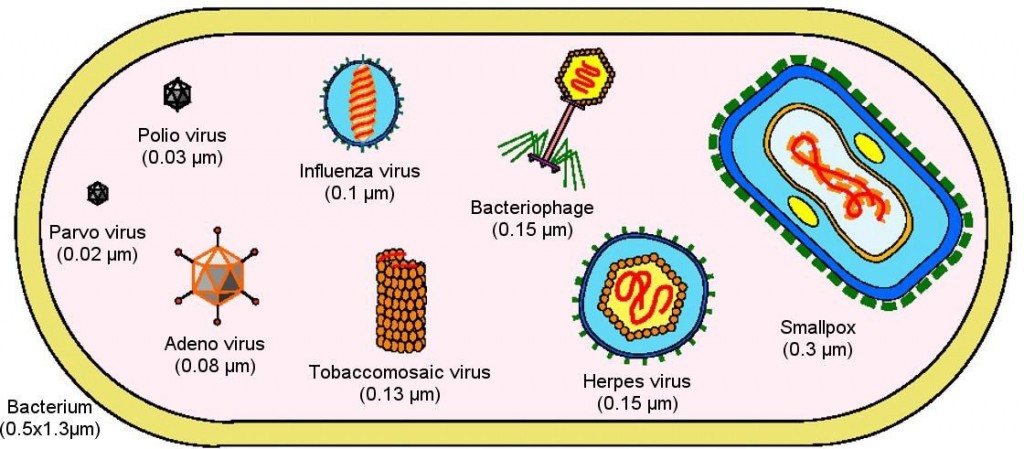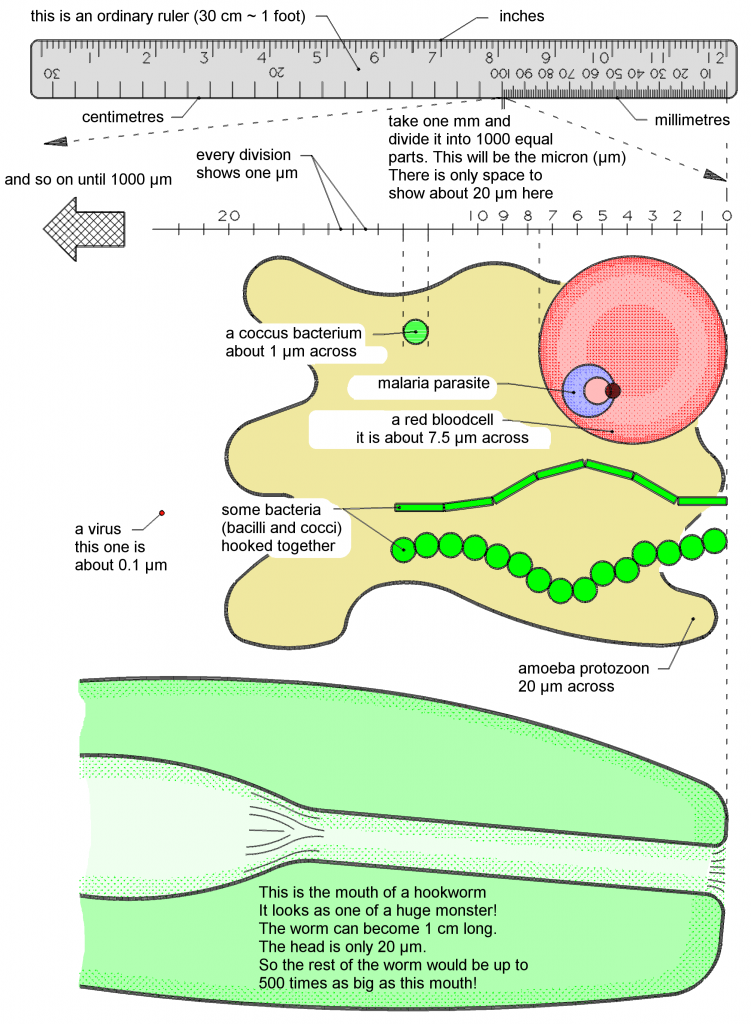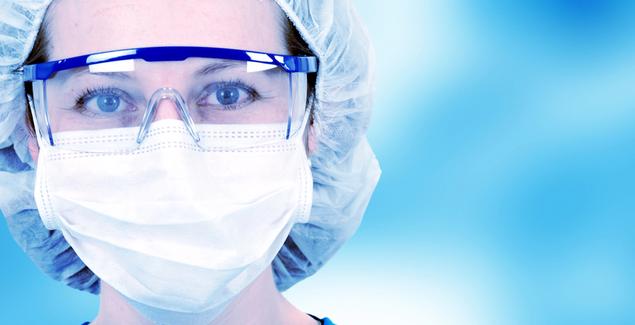Microbiology: study of microorganisms
As mentioned in the previous chapter we came to realise that apart from the bigger organisms there are many, many different microorganisms. In fact there are existing many more different kind of microorganisms than bigger visible organisms! By studying them, mostly aided by the microscope, we came to know more about them. The study of microorganisms is called Microbiology. Although they are very small they have great influence on our lives and we need many of them to be able to survive.
There are many of them living in our guts which help us to digest our food. Others help us making bread rise and brewing beer. They break down waste and make it available to be used as food for other creatures. They perform an often invisible but very important task in the great cycle of life! However some are dangerous and are the cause of fatal diseases. These microorganisms are pathogenic (pathos = disease; genic = to cause).
To give an impression of the numbers of microorganisms in, on and around us, here are some figures:
| Location | Number (approx.) | Number3 | Unit |
| – in our stools | 10,000,000,000,000 | 1012-1014 | per gram |
| – on our skin | 1000 to 1,000,000 | 103-106 | per cm2 |
| – in humid soil | 10,000,000 to | 107-1010 | per gram |
| 10,000,000,000 | |||
| – water of a stream | upto 10,000,000 | 107 | per ml |
| – in tap water | upto 100 | 102 | per ml |
| – in dusty air | 1000 or more | 103 | per litre |
- Many different microorganisms

In the same way as there are many different groups of animals and plants, there are a wide range of microorganisms too. Some are just visible yet by the naked eye; others can only be seen with the most powerful electron microscopes.
Writing very big and very small numbers: The power notation.
| Group of microorganisms |
Size |
Structure |
Group (Nucleus) |
Visibility |
| – Worms | 0.1 mm upto >1 m | Multiple cells | Eukaryote | Big enough to see |
| – Fungi
– Spores of fungi |
5m upto
>1m |
Single or multiple cells Single cell | Eukaryote
Eukaryote |
Some big enough to see. Others are only visible by microscope |
| – Protozoa | 2-20 mm | Single cell | Eukaryote | By microscope only |
| – Bacteria
– Spores of bacteria |
0.3-10 mm | Single cell Single cell | Prokaryote Prokaryote | By microscope only By microscope only |
| – Viruses | 0.002-
0.3 mm |
Only RNA or DNA with or without coat | – | By electron microscope only |
1 micron = 1 mm = 1/1,000,000m = 1/1,000mm = 10-6 m
Writing very big and very small numbers: the power notation. In science often very big and very small numbers are used. For example for the huge numbers of microorganisms. Or the numbers to indicate the tiny size of them. A compact way of writing these big and small numbers was introduced: the power notation or scientific notation. The power notation indicates the number of zeros in the normally written figure. Refer also to Appendix 3 for a complete list of the metric prefixes.
|
Big numbers |
nr of zeros | power notat |
Small numbers |
nr of zeros | power notation |
| 1
10=10×1 100=10×10 1,000=10x10x10 10,000=10x10x10x10 100,000=10x10x10x10x10 1,000,000=10x10x10x10x10x10 |
0
1 2 3 4 5 6 |
100
101 102 103 104 105 106 |
1/1
1/10 1/100 1/1,000 1/10,000 1/100,000 1/1,000,000 |
0
1 2 3 4 5 6 |
10-0
10-1 10-2 10-3 10-4 10-5 10-6 |
| etc… |
| PARTICLES AND MICRO- ORGANISMS | VISION RANGE MICROSCOPE | Size
m |
Some examples |
|||
|
tobacco smoke |
viruses |
droplets drizzle
droplets of haze
droplets of clouds and fog
soot |
elec- tron micro scope |
Normal light micro scope |
1000 | (1000µ=1mm) |
| 900 | ||||||
| 800 | needle | |||||
| 700 | ||||||
| 600 | ||||||
| 500 | ||||||
| 400 | ||||||
| 300 | thickness razor blade | |||||
| 200 | ||||||
| 100 | ||||||
| 90 | ||||||
| 80 | thickness human hair | |||||
| 70 | ||||||
| 60 | flour | |||||
| 50 | ||||||
| 40 | smallest visible | |||||
| 30 | particle | |||||
| 20 | pollen; aluminium foil | |||||
| 10 | ||||||
| 9 | ||||||
| 8 | ||||||
| 7 | ||||||
| 6 | red blood cell | |||||
| 5 | yeast cell | |||||
| 4 | ||||||
| 3 | ||||||
| 2 | ||||||
| 1 | S. aureus | |||||
| 0.9 | ||||||
| 0.8 | ||||||
| 0.7 | ||||||
| 0.6 | ||||||
| 0.5
0.4 |
P. aeruginosa | |||||
| 0.3 | ||||||
| 0.2 | ||||||
| 0.1 | ||||||
| 0.09 | ||||||
| 0.08 | ||||||
| 0.07 | ||||||
| 0.06 | ||||||
| 0.05 | ||||||
| 0.04 | ||||||
| 0.03 | ||||||
| 0.02 | ||||||
| 0.01 | ||||||
| 0.009 | ||||||
| 0.008 | ||||||
| 0.007 | ||||||
| 0.006 | ||||||
| 0.005 | ||||||
| 0.004 | ||||||
| 0.003 | ||||||
| 0.002 | ||||||
| 0.001 | ||||||
Diagram which helps to compare ranges of sizes of all kind of common small particles to those of microorganisms. Also it shows the range of sizes which is used for observation by a normal light microscope and when an electron microscope is needed.

Getting an idea about the sizes of microorganisms. Compare them to the size of a ruler. A small round bacterium, called “coccus” is about 1m (1/1000 mm) across. You have to put 1000 of these bacteria in a row to make a line as short as 1 mm! The thickness of a human hair would, when shown in the same scale, be about 3 times the width of this drawing.
Worms
Most of them are large enough to be seen. Many live in the people’s intestines and cause diseases. Some of them are the roundworm, hookworm and tapeworm. Worms may cause all kind of health problems ranging from itching, tiredness, anaemia to even death. Also bilharzia is caused by a kind of worm.
Worms vary in size. From a few millimetres to several meters! There are many types of worms that live in people’s intestines and cause diseases. The roundworms and tapeworms are sometimes seen in the stools. Some types enter the body when drinking dirty water or eating poorly boiled meat in which they live.
Fungi

They are very simple plants. Mostly they are single celled microorganisms, but some fungi contain many cells and are large enough to see. Like plants they cannot move by themselves. The yeast we use to brew our beer and bake our bread is a fungus. The life saving drug penicillin is produced by a fungus. But some of them cause skin diseases, such as athlete’s foot, tinea and ringworm. The latter disease is not caused by a worm but by a fungus growing in the shape of a ring. Some fungi (for example Aspergillus and Cryptococcus neoformans) can also infect internal organs like the lungs and brain. Probably you know the Aspergillus niger from the black layer on the wall in a humid bathroom or on the side panels of a refrigerator.
Fungi. Yeast is a fungus that helps making bread and brewing beer. They also help decaying dead organic substances. If the bread is not eaten, it will be eaten by another fungus: the bread mould.
Protozoa

Protozoa are usually smaller than fungi and measure about 10-20 µm, and are made of one (eukaryotic) cell. An amoeba is a type of protozoon which moves slowly by putting out a kind of “feet” (pseudopodia). Others can move very fast by swinging a kind of hairlike tail (like a fish moves). Some produce seeds (cysts) which are like seeds of plants and can survive dryness and heat. Some diseases caused by protozoa are malaria (caused by plasmodia), sleeping sickness (caused by trypanosomes) and amoebiasis (caused by amoeba).
Protozoa: beautiful, amazing shapes, but sometimes dangerous killers! Malaria is caused by a protozoal parasite (plasmodium), which lives, grows and multiplies in our blood.
Bacteria
These are so small that without a microscope they cannot be seen. That is why it took such a long time before we realised that they existed! They vary in size between 0.3 – 10 µm. Bacteria are made up of one cell. A major difference with all other microorganisms presented so far is that the cells of bacteria don’t have a nucleus: they are prokaryotes.
Bacteria can be grouped according to their shapes. Some diseases which they cause are indicated.
Thousands of different types have been discovered. Many of them are harmless and are even essential for our lives. They break down dead plants and animal material into its chemical parts so that they can be re-used by growing plants. Without the work of bacteria, life would soon come to an end! As in all other groups of microorganisms there are some which can cause serious diseases.
see also:
Low-Temperature Sterilization – What You Need to Know
STERILIZATION of Medical Supplies by Steam – Part 1

